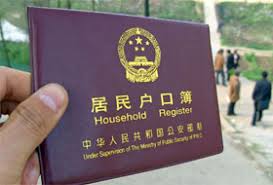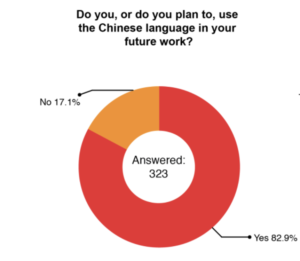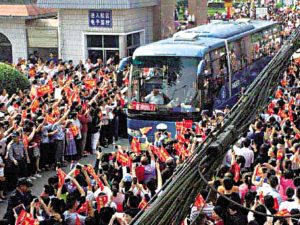a hukou book’s photo (photo by Chengdu Living)
A Chinese migrant worker couple Jianhong Fang and Zhou Wang have worked in Suzhou, one of wealthiest cities in China with high GDP per capita 145,205 CNY (21,868 USD), for the past 15 years. They work at the same electronic factory, earn money to support their daily lives and send the rest of the earnings to their parents and eight-year-old son Ming Wang.
Ming Wang has studied at his hometown Yancheng with his grandparents for the past eight years. Although in the same province, Yancheng’s economic development is much slower than Suzhou does. The city’s GDP per capita was 58,299 CNY (8,780 USD) in 2015, 0.4 times of Suzhou’s GDP per capita.
What has distinguished Ming Wang and his parents is the hukou system, a household registration system that the government has implemented to allow each citizen to only enjoy their social benefits in the registration place and then control population imbalance within big cities.
According to the China Labour Bulletin, there were more than 287 million rural migrant workers in 2017, making up 36 percent of the entire working population in China. Because of the natural drive of the economy, workers who were born in an urban area tend to search for a job in a metropolitan area. China’s economic rise has relied on these rural migrants.
Although some workers may access the healthcare and social benefits of their working cities by having their employers paid accumulation funds for them, their children usually cannot go to school in their working cities.
Ming Wang’s hukou is in Yancheng. So, without giving up their satisfying jobs in Suzhou, Fang and Wang may never live together with their little son.
Children like Ming Wang have been called “left-behind children,” which means migrant workers have left their children with family members, usually children’s grandparents, in their hometown.
At the end of 2015, Fang and Wang decided to have a second child after the Chinese Communist Party announced the new two-children policy, which allows Chinese couples to have two children without paying extra fees, would replace the old one-child policy.
After one year, their second son Jin Wang was born. Fang and Wang said because of the revision of the hukou policy in 2014, they may be able to let their second son to be educated in Suzhou.
The History & Revision of the Education Hukou Policy
The vast population of China requires its government to control labor distributions within each region more effectively. Therefore, since 1949, the Chinese government has used the hukou system to assign each citizen a household registration identity. Each citizen has a hukou that demonstrates his or her name, date of birth, citizen identity number and, most importantly, birthplace. This is a pass for everyone to access education, healthcare, housing and other social benefits locally.
In 1949, due to the lack of transportation and slow-development of the economy, most Chinese citizens tended to stay where they were born.
The hukou system had its first revision in 1958 that set a rural and urban divide. Specifically, children were required to stay at their hukou registration places to achieve an education. However, more migrant workers wanted their children to go to school in the city they worked. For example, although Ming Wang was born in Suzhou, he was still defined by the policy as a migrant child and should go back to his parents’ household registration place to achieve an education. In 2001, 20 percent of the youth population in China were migrant children.
Therefore, hukou policy had its second revision in 2014, which allows migrant children to go to school in cities. This is why Jianhong Fang and Zhou Wang couple immediately had their second child after the new hukou policy and the two-child policy was published.
The Chinese central government and the education department have designed to allow migrant children to receive education in cities. Based on the Chinese Ministry of Education policy, all migrant children are encouraged to complete nine-year compulsory education (six-year elementary school and three-year middle school) in the city that their parents work. According to China’s mandatory education policy, public school usually charge a small fee, which is about 700 CNY (100 USD) per semester.
Zhou Wang said they would keep their second son with them this time.
Where Can Migrant Worker’s Children Get Educated In The Cities Now?
Public School
Based on the education policy, the education cost of a public school should have no significant difference with a migrant school. Therefore, if given a fair chance, most migrant parents would choose a public school for their children due to the experienced teachers and good-quality equipment there.
However, discrimination among migrant students is still alive at most public schools in the cities, according to the new analysis in the Global Education Monitoring Report.
Reputable public schools in the cities have the right to fill up local students first and usually leave no space for migrant students. Even when some public schools open some seats, local governments and schools request burdensome paperwork to each migrant applicant. For example, in Suzhou, migrant parents need to present at least five supporting documents, which can be proof of residence, temporary resident permit, work permit, income report, place of origin certificate, etc. Human Rights Watch reported that over 90 percent of migrant families could not obtain these documents.
Although public schools are not allowed to charge extra fees to migrant students, some public schools may still request different kinds of renamed fees such as school selection fees, miscellaneous fees or out-of-district fees.
Additionally, transportation is another extra cost for migrant parents who live on the border of the urban and rural area. In Shanghai and Beijing, migrant workers need to reach certain social credits to purchase a car. However, even the point system application process is overwhelming for most migrant workers. Also, the Chinese government has imposed heavy taxes on automotive goods. Therefore, it usually costs a migrant student more than two hours to reach his or her school by public transportation.
These obstacles have forced migrant students to either choose migrant schools or return to their hukou registration places.
Migrant School
Migrant schools, which usually run privately, are a type of schools designed for migrant students who are not accepted by public schools.
For most migrant parents, migrant schools are always their second option. Unlike well-equipped public schools, migrant schools lack teachers, nutritious food supply, facilities and sometimes even licenses.
Some teachers in migrant schools are retired teachers or volunteers or young graduates. According to the 2013 China Labour Bulletin report, the turnover rate among migrant school teachers was about 51 percent in Beijing because most young teachers treated migrant school positions as their stepping stone to public schools.
The overcrowded public facilities and unqualified lunch is another serious issue. Because migrant parents often busier and pay no attention to children’s dinner food, the limited access to drinking water and poor nutrition food at school make children’s health problems worse.
More importantly, the old migrant education policy didn’t allow any private migrant schools; therefore, most current migrant schools are still illegal or have no teaching licenses. In 2011, the Beijing government closed more than 20 local migrant schools.
According to a recent NPR report, a Beijing migrant school’s volunteer said that her students and their parents feel like being kicked out by the city if the government closes their school.
Although the new migrant education policy was published in 2014, it hasn’t spurred some local governments to build more legal migrant schools. So, the plan has not reached out the majority of the migrant population.
What Has Caused Returned Students?
Migrant workers’ children have made up one of the third student population in China. The new hukou policy has planned to solve their education difficulties. Nine-year compulsory education is one of the most important strategies.
However, discrimination in migrant education cannot be eradicated overnight. ‘Returned children’ refer to the students who have to return to their province of origin after finishing the nine-year compulsory education in the cities.
Furthermore, they have to achieve higher education and take the college entrance examinations, also called gaokao, where their hukou is registered.
The gaokao policy is another invisible disadvantage coming from these children’s hukou. For students who have a hukou of big cities such as Shanghai and Beijing, their college entrance examination is usually designed relatively easy.
In China, most parents have a higher expectation on their children to go to an ideal college because they believe that gaokao is a fair game for every student. If a student wins this game, he or she may have a better chance to enter the middle class. However, the Chinese government still wants to control the population imbalance within a large country. When migrant students pass the scoreline of universities in big cities, they can temporarily hold a city hukou based on their school certificates. The local governments and universities have set score barriers preventing a large number of other provinces’ students from entering their ideal universities.
For example, in 2016, Tsinghua University and Peking University, the top 2 universities in China that located in Beijing, accepted 84 students out of every 10,000 Beijing students and less than three students out of every 10,000 students from other provinces.
Without achieving good-quality education, Ming Wang may never be able to compete with students who have a city hukou. When asked Jianhong Fang and Zhou Wang what kind of future they want for their second son, they said they don’t want Jin Wang to follow Ming Wang’s road.







